- 9 min be taught
- UX,
Assemble Patterns,
Guides
In quite lots of merchandise, atmosphere notification channels on restful is a default, reasonably than an exception. The goal for that’s their high frequency, which creates disruptions and within the waste notification fatigue, when any popping messages receive pushed aside at once.
There is a correct goal for it: high frequency of notifications. In usability checking out, it’s potentially the most frequent grievance, but every app desperately tries to take dangle of a success upon of our attention, sending more notifications our technique. Let’s behold how we would make the notifications UX pretty greater.
This article is fragment of our ongoing series on UX. You could well maybe well more than seemingly secure more critical aspects on receive patterns and UX technique in Gleaming Interface Assemble Patterns 🍣 — with are residing UX training organising soon. Soar to desk of contents.
The Many Faces Of Notifications
Notifications are distractions by nature; they invent a shopper’s attention to a (doubtlessly) fundamental occasion they aren’t attentive to or could well non-public to be reminded of. As such, they are going to be very helpful and relevant, providing assistance and bringing building and voice to the day-to-day routine. Till they’ll not be.
No longer every communication choice is a notification. As Kim Salazar rightfully favorite,
“Save communication generally relies on validation, goal indicators, and notifications. Whereas they’re generally notion to be to be same, they’re if truth be told reasonably diverse.”
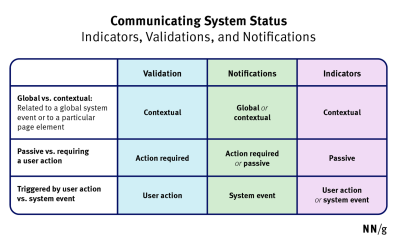
In total, notifications could well be both informational (calendar reminders, lengthen notifications, election evening outcomes) or assist action (approve fee, install an update, verify a friend ask of). They’ll stream from diverse sources and non-public diverse impacts.
- UI notifications appear as subtle cards in United states of americaa. customers non-public interaction with the receive interface — as such, they’re broadly accredited and much less invasive than some of their counterparts.
- In-browser push notifications are harder to dismiss, and plan attention to themselves despite the incontrovertible reality that the customer isn’t getting access to the UI.
- In-app notifications are residing inside desktop and cellular apps, and ought to be as humble as UI notifications, but can dangle a more central goal with messages pushed to the residence display cloak cloak or the notifications center.
- OS notifications equivalent to tool updates or cellular provider changes additionally receive within the mix, generally performing alongside side a wide diversity of notes, calendar updates, and all the pieces in between.
- In the end, notifications can secure their technique into e-mail, SMS, and social messaging apps, coming from chatbots, advice programs, and right other folks.
But we don’t pay the same amount of attention to every notification. It would dangle weeks till they within the waste install a tool update resulted in by their OS notification, or factual about a hours to verify or decline a new LinkedIn ask of.
No longer Every Notification Is Equal
The degree of attention customers grant to notifications relies on their nature, or, more particularly, how and when notifications are caused. Folks care more about new messages from shut company and relatives, monetary institution transactions and disturbing alerts, calendar notifications, and any actionable and awaited confirmations or releases.
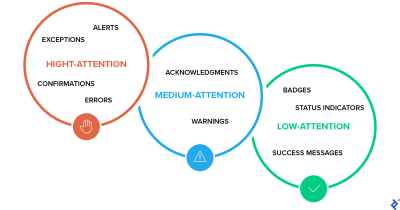
Folks care much less about news updates, social feed updates, bulletins, new aspects, shatter experiences, promotional and computerized messages customarily. Most importantly, a message from one other human being is repeatedly valued worthy greater than any computerized notification.
Assemble For Stages Of Severity
As Sara Vilas suggests, we can ruin down notification receive at some level of three ranges of severity: high, medium, and low attention. And then, notification sorts non-public to be extra outlined by remark attributes on these three ranges, whether or no longer they’re alerts, warnings, confirmations, errors, success messages, or goal indicators.
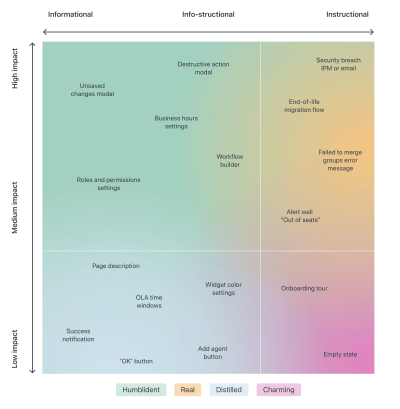
Excessive Attention
- Signals (rapid attention required),
- Errors (rapid action required),
- Exceptions (diagram anomalies, one thing didn’t work),
- Confirmations (doubtlessly destructive actions that need client affirmation to proceed).
Medium Attention
- Warnings (no rapid action required),
- Acknowledgments (suggestions on client actions),
- Success messages.
Low Attention
- Informational messages (aka passive notifications, one thing is ready to seem for),
- Badges (in total on icons, signifying one thing new since closing interaction),
- Save indicators (diagram suggestions).
Taking it one step extra, we can contrivance the eye against the kind of messaging we are providing — very same to Zendesk’s mapping tone above, which plots affect against the kind of messaging, and reveals how the tone ought to regulate — turning into more humble, right, distilled or charming.
So, notifications could well be diverse, and diverse notifications are perceived otherwise; nonetheless, the more non-public, relevant, and timely notifications are, the greater engagement we must at all times build a question to.
Commence up Sending Notifications Slowly But Frequently
It’s no longer unprecedented to ticket in, handiest to realise about a moments later that the inbox is filling up with all sorts of beside the level messages. That’s precisely the substandard thing to receive. A hit upon by Fb showed that sending fewer notifications improved client satisfaction and prolonged-term usage of a product.
On the starting save, once the notification rate became diminished, there became certainly a loss of traffic, but it absolutely has “step by step recovered over time”, and after a long interval, it had completely recovered and even grew to turn out to be out to be a fabricate.
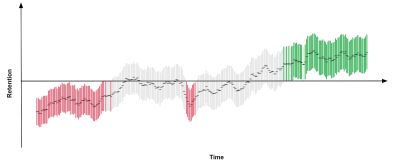
A right starting level is to avoid wasting up a unhurried default notification frequency for diverse sorts of shoppers. As the client retains using the interface, we would build a search data from to them to judge on the roughly notifications they’d desire and their frequency.
Ship notifications slowly, and over time slowly amplify and/or decrease the amount of notifications per kind of buyer. This could occasionally maybe well work worthy greater for our retention charges.
Don’t Rely On Generic Defaults: Location Up Notification Modes
On the total, customers can make a selection in and make a selection out of each and each single kind of notification of their settings. In total, it’s a correct advice, but it absolutely can additionally be very overwhelming — and no longer essentially certain how critical every notification is. Alternatively, we would provide predefined instructed suggestions, seemingly with a “tranquil mode” (low frequency), a “ordinary mode” (medium frequency), and a “strength-client mode” (high frequency).
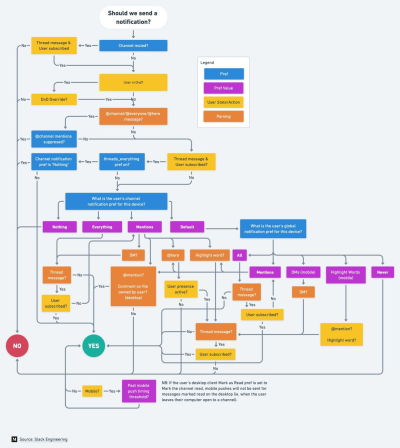
As time passes, the structure of notifications could well need changes as wisely. Barely than having notifications despatched one after the other as events happen, customers could well resolve a “abstract mode,” with all notifications grouped right into a single standalone message delivered at a remark time day after day or per week.
That’s one in all the settings that Slack provides by strategy of notifications; without a doubt, the diagram adapts the frequency of notifications over time, too. On the starting save, as Slack channels could well be reasonably silent, the diagram sends notifications for every posted message.
As activities turn out to be more frequent, Slack recommends lowering the notification degree so the customer could well be notified handiest when they’re if truth be told mentioned.
Develop Notification Settings A Portion Of Onboarding
We’d additionally consist of frequency suggestions in our onboarding receive. A whereas relief Basecamp, to illustrate, has launched “In any admire times On” and “Work Can Wait” suggestions as a fragment of their onboarding, so new potentialities can pick within the occasion that they’d favor to receive notifications as they happen (at any time), or resolve remark time ranges and days when notifications could well be despatched.
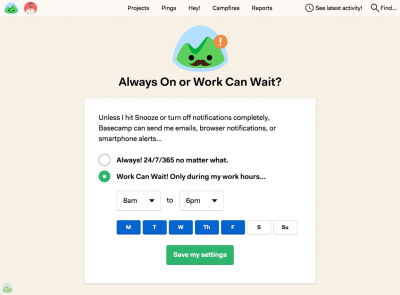
Or, the different route around, we would build a search data from to customers when they don’t non-public to be skittish, and suspend notifications at that time. No longer every buyer desires to receive work-connected notifications outdoors of industry hours or on the weekend, despite the incontrovertible reality that their colleagues could well be working extra hours on Friday evening on the opposite side of the planet.
Allow Users To Snooze Or Terminate Notifications
User’s context changes repeatedly. At the same time as you stare an unprecedented drop in engagement rate, or once you’re waiting for an strangely high volume of notifications organising (a birthday, marriage ceremony anniversary, or election evening, seemingly), keep in mind providing an choice to restful, snooze, or stop notifications, seemingly for the subsequent 24 hours.
This could occasionally maybe well budge very worthy against our intuition, as we would ought to re-engage the client within the occasion that they’ve long past silent all of a sudden, or we would ought to maximize their engagement when critical events are taking place. Nonetheless, it’s easy to attain a level when a reputedly harmless notification will steer a buyer away, future.
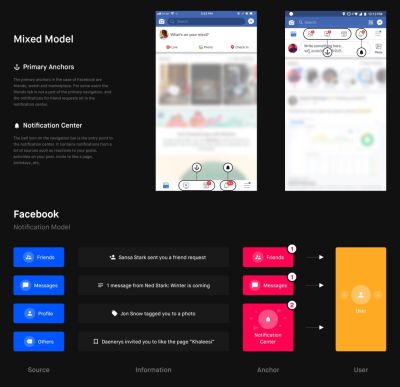
One other choice could well be to counsel a alternate of medium venerable to bask in notifications. Users are inclined to affiliate diverse ranges of urgency with diverse channels of communication.
In-app notifications, push notifications, and text messages are notion to be to be rather more intrusive than right ol’ e-mail, so when frequency exceeds a undeniable threshold, it is seemingly you’ll maybe well ought to nudge customers in direction of a switch from push notifications to day-to-day e-mail summaries.
Wrapping Up
As repeatedly in receive, timing matters, and so receive timely notifications. Commence up slowly, and evolve your notification frequency reckoning on how precisely a shopper if truth be told uses the product. For every kind of client, save up notification profiles: frequent customers, infrequent customers, one-week-ride customers, one-month-ride customers, and so forth.
And whenever that it is seemingly you’ll maybe well mediate, permit your customers to snooze and restful notifications for a whereas. In the waste, it is seemingly you’ll maybe well even ought to counsel a alternate within the medium venerable to bask in notifications. And when in doubt, lengthen, reasonably than sending through.
Meet “Gleaming Interface Assemble Patterns”
You could well maybe well more than seemingly secure more critical aspects on receive patterns and UX in Gleaming Interface Assemble Patterns, our 15h-video route with 100s of shining examples from right-lifestyles initiatives — with a are residing UX training later this year. All the pieces from mega-dropdowns to advanced undertaking tables — with 5 new segments added yearly. Soar to a free preview. Utilize code BIRDIE to place 15% off.
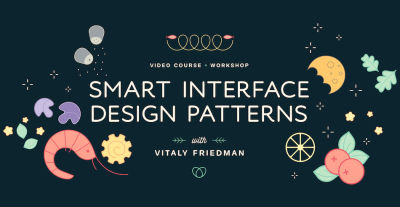
(yk)






